Don't wanna be here? Send us removal request.
Text
Innovation Campus
by Nargis Mamedova, 01 April 2020, Hamburg

Incubators are the places where ideas become businesses - where start-ups receive support and guidance as they approach the market and seek investment. There are hundreds of incubators around the world - I have listed three that have achieved the best results in recent years, making them the best places to start a new digital business.
A campus for all
From idea generation, the pre-foundation phase, start-up and market entry to support in the first growth phase, the Innovation Campus offers an all-round service with targeted services in the respective development phases.
The combination of scientific teaching and transfer is also unique, as founders have the opportunity to receive support during their studies.
The network is of great importance, but also among the different universities themselves, a close exchange is of great importance.
An innovation campus not only has the rooms in which start-ups, students etc. can develop, but also advisory and support structures, which are also being further developed. Mostly they are in close exchange with other universities and look very positively into the future.
Development of an Innovation Campus Space, innovations and expertise for a digital future
The Innovation Campus has set itself the task of attracting supporting members, investors and project partners for projects - the establishment of an Innovation Campus offers start-ups, young talents, students..., the chance to create a comprehensive cooperation network between digital technologies and services, industry, research, the knowledge society and innovative start-up companies in order to work together on the development of sustainable technologies and innovative customer solutions. The infrastructure of such an innovation campus is a perfect location, it not only enables the know-how of the partners involved, but is also an active platform for the development of digital innovations and business fields of the future, and aims at accelerating learning processes in order to quickly develop new business models.
The basic idea of the Innovation Campus is to bring together different developments and systems from different areas on one site; to further develop and optimize them in real life and practice-oriented applications.
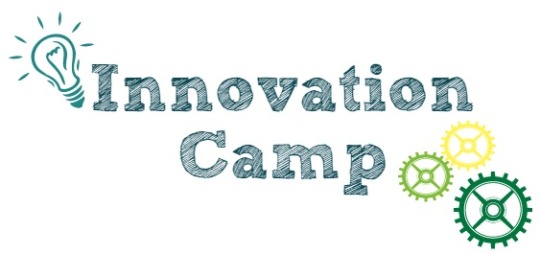
Innovation Campus - Future security through cooperation
An innovation campus can represent interesting interfaces between various actors in the innovation field. Here, traditional companies with generations of practical experience meet innovative future technologies from science and start-ups. With the realization of an Innovation Campus there can finally be a place for this meeting.
Through the exchange of members, old patterns of thought can be questioned in an uncomplicated way, while at the same time proven methods are retained. In this way, unique selling propositions are preserved and innovation brakes are removed. An Innovation Campus offers a cross-sectoral development environment for companies and businesses of all sizes. Those looking for solutions will find information, ideas and room to experiment. A network of qualified creators is included in an Innovation Campus and is maintained and expanded. Thus project teams are brought together with relevant experts for prototyping or implementation after the brainstorming.
Innovation Campus - modular principle
The concept of the Innovation Campus has a modular structure. After defining an initial module, such as a CoWorking Space, further elements such as an Eventspace or Makerspace can be added. This allows to react quickly to new circumstances and to increase the capacity and effectiveness of an Innovation Campus by adding further elements.
Output: CoWorking Space
"Coworking Spaces" provide workstations and infrastructure (network, printer, scanner, fax, telephone, beamer, meeting rooms) for a limited period of time and enable the formation of a community, which can be strengthened through joint events, workshops and other activities. The difference to the office community is the mixture of different professions and the lower commitment.
Modul: Eventspace
Many different events can be organized in one event space. Be it a conference with a large number of speakers in one day, a hackathon over an entire weekend, panel discussions, networking events or even evening workshops. This kind of location offers with its equipment a very comfortable "plug and play" setup for any kind of event.
Modul: Makerspace
A MakerSpace is an open workshop with the aim of providing private individuals and individual tradesmen with access to modern manufacturing processes for unique pieces. Typical devices are 3D printers, laser cutters, CNC machines, presses for deep drawing or milling to be able to process different materials and workpieces. There is overlap and cooperation with educational institutions such as schools and universities, the open hardware, open source and DIY movement.
Further modules as required
Depending on the requirement profile and local conditions, further modules such as learning facilities, testbeds (test sites) or others can be combined to create a tailor-made innovation campus.
Perfect work base:
The exchange in research and development work is extremely helpful. In addition to good technical equipment, a creative and natural working environment as well as quiet retreats are needed. This is what the campus offers, coupled with the certainty that ideas and inventions are safely accommodated on site.
0 notes
Text
Maker Space
by Nargis Mamedova, 06 May 2020, Hamburg
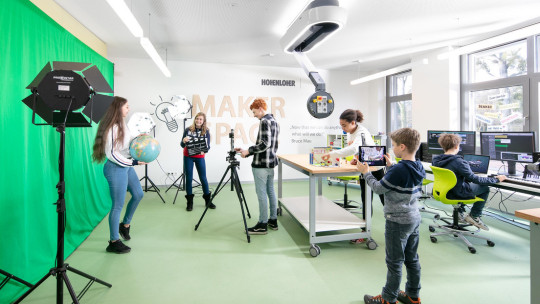
Maker Spaces: More than just co-working
The principle of co-working should be known by almost everyone by now: Several people from different fields meet at one place - usually in loft-like offices - and work together. The great advantage of co-working is the constant exchange between the participants and the resulting new approaches and ideas. However, the idea of community does not only bear fruit in classic desk work. So-called Maker Spaces take up the idea of Co-Working Spaces and think one step further. This is where theory goes over into practice.
What is Maker Space?
Roughly speaking, the Maker Spaces are modern hobby or craft rooms in which creative people come together and work together on different projects. The whole thing is under a clear message: Do it yourself.
As a place for creative meetings, Maker Spaces are of course also the perfect breeding ground for completely new ideas and ways of thinking. This becomes all the more apparent when one considers the two primary goals of these special places:
· providing knowledge and opportunities for implementation outside the normal education system
· Networking (with like-minded people)
The places are created specifically to promote creative exchange between different people - where we would in principle be back at the co-working spaces.
What distinguishes Maker Spaces or FabLabs in general, by the way, was recorded in the Fab Charter.
Below is a selection of the Maker Spaces in Germany.
- FabLab Berlin
- FabLab Bayreuth
- FabLab Dresden
- FabLab Rothenburg
- FabLab Graz
- TechnologyBakery Bermatingen
- FabLab Munich
- Cottbus FabLab
- FabLab Oldenburg
- Hackerspace Metalab Vienna
- FabLab Lüneburg
- FabLab TECFA Geneva
- Science Shop Potsdam
Maker Spaces as part of the university landscape
It is important to know that most FabLabs are part of local colleges and universities. This fact underlines once again the educational value of the Maker Spaces and why they are so important for professional development.
At universities in particular, which are usually highly theoretical in nature, it is important for students to be able to try things out in the Maker Spaces and consolidate their knowledge on a practical level. What is otherwise only possible in internships is taught here in the environment of the university institution and is available to students at all times.
The Maker Space for everyone
Maker Spaces and FabLabs do not only cover the field of technology, but also classic craftsmanship areas such as: ( photography, woodworking, metalworking, electronics, textile processing).
VIDEO https://www.youtube.com/watch?v=NLEJLOB6fDw
The Leipzig Maker Space shows how versatile the FabLabs can be and what possibilities they can provide.
The equipment ranges from computers, laptops and iPads, to various software, musical devices and instruments, to 3D printers and truck cutters, in order to bring his ideas into shape and create something tangible and physical.
This means that really everything can be created in Maker Spaces - from prototypes to new apps. Participants have the opportunity to try out themselves, their thoughts and brainstorms and at the same time exchange ideas with others who, at best, share their own interests.
Maker Spaces solve several problems at once and turn them into their own advantages:
Ideas can be discussed and developed together.
Equipment is provided by Maker Space.
Communities with similar interests develop

0 notes
Text
New innovative technologies and developments in architecture
by Nargis Mamedova, 25 June 2020, Hamburg
In interior design, digitisation is taking place on two different levels: On the one hand, there is the digitalization of the planning processes of how we interior designers conceive, develop, communicate, exchange and present a project and increasingly make use of digital media. On the other hand, it is the digitalization of the environment we design, i.e., the progressive integration of technology to create an "intelligent" or "smart" building interior in order to make room climate, security, ambience and entertainment controllable from any location, even from a distance.The wealth of available furnishing apps now allows almost anyone to try their hand at furnishing. To offer the customer a virtual walk through his future home - worked out to the last detail including the vase with the favourite flowers - is in my opinion a good development but still not the task of the interior designer. I still think we should rather stimulate the imagination of our customers and allow them to experience the feel of the materials used with real material samples. The process of making a drawing real is also much more exciting than realizing that reality cannot always quite match the virtual world.
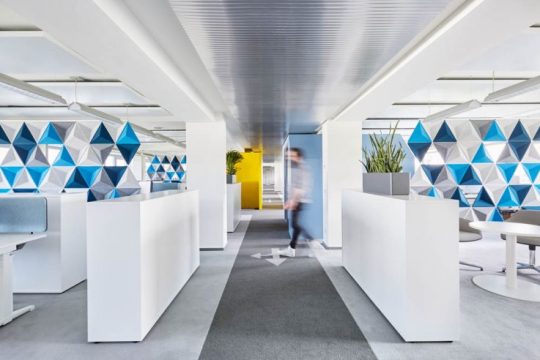
Digitalisation is changing the way we live together, the design of our rooms and the products we use. We say goodbye to the familiar and gain something new.
With increasingly complex data models we can design and optimize planning processes more precisely. We can also communicate the quality of a project more and more clearly. On the other hand, we are thus in a very early stage of planning.
But...
Is the progressive digitalization of work as interior designers changing?
I think the way interior designers work is changing and evolving. Today, work can take place partially independent of location, which makes planning processes more flexible and efficient. At the same time, the speed of transformation is increasing enormously. Information and data can be exchanged from anywhere and in real time. This brings decisive advantages for the cooperation with specialist planners. With increasingly complex data models, planning processes can be designed more precisely and optimized. Sources of error are thus detected and avoided at an early stage. Components such as light or materials can also be included much earlier in the project design and can be changed more easily with just one click
What possibilities are there for the future in view of the increasing importance of digital media?
Thanks to virtual 3D models, we can communicate the quality of a project more and more clearly. Realistic renderings are now expected and are becoming increasingly complex thanks to virtual reality. This enables clients to have a better idea of the design.

Nowadays there are technological advances that help designers to create intelligent and efficient spaces. Some of these technologies have been around for a long time and some are comparatively new. In some of my projects I have worked with the new technologies. In a co-living, co-working spaces, such systems would play an important role.
I have added some modern technologies that might be interesting.
VR Virtual Reality architecture
https://www.youtube.com/watch?v=xpjhsOneeQQ
Smart Textiles
https://www.youtube.com/watch?v=EAPWFY4_8Eg
Smart home of the future
https://www.youtube.com/watch?v=_bUj-xZekf8
Perhaps interior design has a balancing function here: the more digital our living environment becomes, the more our own four walls must be authentic. The more our everyday life takes place virtually and globally, the more tangible and concentrated our environment must be. Visual calm and tangible authenticity are then all the more necessary ingredients of our design concepts.
Thinking like a user
Work processes, no matter what kind, are characterized by recurring actions, events, contacts and places. As an interior designer, I also recognize rituals in them, which in our designs represent the all-determining starting point of spatial planning. Rituals represent a decisive connection between the two poles of sedentariness and the newly lived nomadism in the office.
One of the strongest and most conscious rituals is probably the walk into the lunch break. Eating and perhaps even cooking together is becoming increasingly important as a team-building element. Kitchens and bistros are places where you can be creative and express your identity. Beyond coffee and lunch breaks, places where people eat lunch can be used as venues for events in the evening. Often these positively occupied places are then also used spontaneously as flexible workplaces.
0 notes
Text
Perspektive - Generation Z
by Nargis Mamedova, 25 June 2020, Hamburg
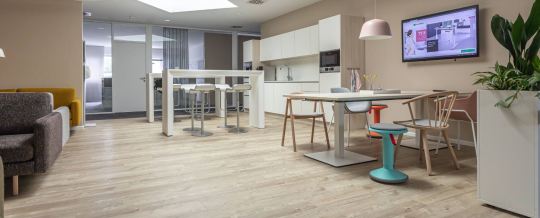
What comes after video telephony? And how do architects design working worlds in which baby boomers and the next generation of Generation Z feel comfortable together….
There have been several innovations in the history of offices. Computers, video telephony, 3D printers. What will be the next big step in development?
I don't think it is a technical innovation, but that doesn't make it any less important: the so-called "shared desks" could become established in the office in the long term. No employee has his or her own place anymore, but sits where something is free at the moment. More and more people work remotely and no longer need their own desk. The laptop virtually replaces the stationary workplace with all its utensils on it. People are already working digitally anyway - sometimes from the office, sometimes from home, sometimes from a business trip or from the coworking space around the corner. The needs of the workers should determine where and how work is done.
An example: Project managers in agencies need the consultation on site, but also space to develop new ideas in small groups elsewhere, and peace and quiet to work conceptually. Depending on the need that needs to be satisfied, the workplace changes all the time. Why then set up a desk for each individual person, if not everyone is always on site anyway?
1. an office consisting of "shared desks" also has two major advantages: the required office space will shrink. This saves rental costs.
2. the flexible spaces will create more exchange within the workforce, which will benefit the team structure.
Caution is still required: The trend does not mean that dogmatic adherence to the open-plan office, even if many believe that. An employer should nevertheless provide small retreat rooms - so-called "silent rooms". In an office with "shared desks" we have to respect different needs.

I find the topic of Smart Office very exciting. Smart solutions have already established themselves in private households. More and more people are using intelligent refrigerators, automatic irrigation systems and mowing robots in the garden. These systems can be easily controlled via apps.
The Smart Office brings many advantages. For example, an intelligent desk could remind employees to change to a standing position regularly. This desk would be able to analyse usage. We can use the values to optimize maintenance and determine the utilization.
Of course we have to feed these systems with data to make them work. The more individual values, the more precise the tailored offers. But we all know how sensitive the topic of data protection has become in recent years. This is especially true for Generation Z. It is extremely exciting in this respect, because it is not only when it comes to data that the generation is growing into companies in a completely different way than the previous generation.
The new generation promises change
How can furniture manufacturers serve this striving for uniqueness in the office? The ability to individualise is becoming more important. Furniture must be adaptable by the employees. By this I don't just mean height-adjustable tables or shelving systems that we change by hand. Employees should get the feeling that their own workplace can be individualised and corresponds to their personality. This is perhaps even more about the feeling of being able to adapt something than about the change itself.
An idea that I find very charming in this respect: involving the employees in equipping the workplace. That starts with the technology and ends with the choice of furniture. This is an opportunity for companies to show their appreciation.
I experienced this myself when I was asked, as a new employee, what I needed to work optimally. They were actually able to fulfil my wishes relatively easily. There was a very positive reaction. Appreciation is and will remain an extremely important motor of motivation in the future.
0 notes
Text
Coliving-Coworking
by Nargis Mamedova, 24 April 2020, Hamburg

Coliving, coworking, housing - the "coexistence" of real estate is gaining momentum
Work, life, housing: Everything seems to need a "co". The classic flat share, the classic office and also the classic single-family house seem to have lost their appeal. Generations Y and Z are striving for new concepts of living and working that are better suited to their needs and preferences. Experiences instead of possessions are becoming more and more important. Coworking, coliving and housing have developed in this way.
Coworking: The classic office has had its day
The traditional office seems to be losing its importance for the younger generation. The self-employed and founders, the digital nomads, only need a notebook to work on their projects. They always have their "office" in their backpack. But if you no longer meet your colleagues every day and only communicate via Skype and Co., it can get quite lonely. This is where the coworking spaces come in.
Coworking creates the opportunity to network with other co-workers after or during work, to get to know them better over a coffee or an evening event.
Problem: For many of them, they usually go home alone afterwards - possibly to a micro-apartment, as they often change their place of residence and do not need their own furniture anyway. Those who live like this are threatened with social isolation. One solution to this is Coliving. You not only work together, you also live together!
Coliving - shared apartment with all service
But what exactly is Coliving? In simple terms, it is a new type of classic shared flat - just for working people. Just like coworking, you exchange ideas with like-minded people and benefit from each other's know-how, new ideas and the residents' network. With the difference that all this does not take place in an office, but in a shared apartment.
Flexibility and simplicity: the engines of our time
Sociability is only one aspect of this. As with micro-living, the user of colivings is driven above all by the desire for high flexibility and simplification. Added to this is the need to belong to an exclusive community with limited access. The all-inclusive approach of the providers is marketable. Users want everything from a single source and already included in the price. Of course, none of the creative residents want to have to worry about the cleaning plan or affordable furniture. Coliving must therefore offer a complete package and a clear added value compared to classic living alternatives.
In addition to high-quality and space-efficient furnishing, features such as cleaning, fitness studio, library, coworking areas, SPA areas, lobby & concierge, roof terrace, games room, urban gardening, night club or member apps are just some aspects of successful concepts. In addition, there are exclusive events such as parties or cooking events within the community.
Another growth driver is of course the housing shortage in the conurbations - although many users do have the financial means to live in their own four walls, but consciously opt for coliving.
The concept has yet to prove itself
However, coliving is not an automatic process - the composition of tenants, target group-specific equipment and services are crucial for success. While the drivers of coliving are stable, many concepts still have to prove their efficiency in the market. The best example is WeLive from WeWork.
Co-Living enables a creative and colourful life
Co-Living is aimed specifically at the self-employed, at founders of start-up companies, at young people who can work from anywhere, at creative people, at people who like to travel a lot, at so-called 'digital nomads' or at students. Living in co-living communities is very popular. In large residential properties in central, urban locations there are several furnished shared rooms. The rooms are furnished according to current trends and are very comfortable. There are modern kitchens and common rooms. The Co-Living houses are additionally equipped with fitness areas, gardens, work spaces, pools, roof terraces, laundries, yoga studios or libraries.
The residents of Co-Living houses should feel comfortable, so that they are able to work inspired and live creatively. Co-Living is a helpful blend of work and private life.
0 notes
Text
Co-Living – Interior Design
by Nargis Mamedova, 24 June 2020, Hamburg
Developments in the fields of architecture, interior design and technology, as well as co-living and co-working spaces are constantly being developed and redefined. Hybrid design is the new addition that offers cultural diversity to the community, which in turn has a modern living and working space.
Co-Living rooms are actually rooms that adopt hybrid designs to promote effective use of space while keeping technology at the fingertips of the occupants. As mentioned in the last article (https://nargisdesignblog.tumblr.com/post/621000663200153600/coliving-coworking), the rooms have separate bathrooms, a small galley kitchen, and other facilities such as a gym, retail, activity rooms, laundry and much more. All these services are planned within the building or directly in the surrounding area, with a focus on user-friendliness. Because it is the sense of community that operatively drives such places.
The Co-Living concept of living and working together should be made more hybrid to create more efficient spaces. People basically need three environments to feel comfortable in life and to achieve serenity. The social place - the workplace - and the home. The home is a place where a sense of personal responsibility is created and privacy is protected. The second place goes to the office - a place where all the entrepreneurial ideas thrive and where economic strength is needed to sustain them. The Social Place, is the most needed environment, as it is necessary for physical and emotional bonding with like-minded people to claim social status. The three areas determine the entire living space and environment. The common living and working style has influenced the merging of residential, workplace and social areas into a communal living area, which has ultimately influenced the requirements of the real estate sector.
What value does a good design bring to coliving?
„One of the most exciting things about coliving in the modern context is that it can create intellectual conglomeration. If people can live in an environment where they can engage in meaning conversations, then there is value creation by means of density. Architects have a lot of power this way because we have the tools to create opportunities for interaction between people.
A great designer will solve problems you didn’t even know you had. They are not just good at composition, but at anticipating the needs and issues of the end user. Good design can create pleasant environments and happiness. Proper light and air can’t ever be overrated.
Yoh, Christina. 2019.‘ Zusammenleben definiert aus architektonischer Sicht.‘ [Online] 16. April. Verfügbar unter: https://www.common.com/blog/2019/03/what-exactly-is-coliving/
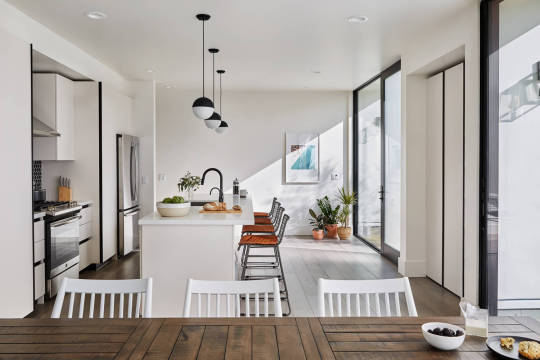
It is a collection of private dwellings with common social areas such as workplace, dining room, entertainment, shopping, bathroom and kitchen, leisure activities, which promotes the reconciliation of work and private life. In this way, residents can talk to like-minded people at every opportunity and form a community that creates cultural diversity.
From an architectural point of view, the design of shared flats is not limited to private rooms and facilities, but there are also public and private living areas that are divided within the building. The transition to the different areas is fluid. One room leads to the next. From the dining area to the work room, - short conversations can be held in the spaces in between. This is where the hybridization takes place.
0 notes
Text
Coworking Spaces in Hotels (Part 1 + Part 2)
by Nargis Mamedova, 06 April + 16 April 2020, Hamburg
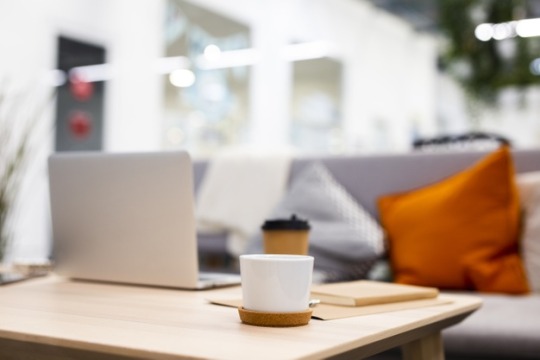
I first heard about and used co-working spaces four years ago.
For my master project I came across the topic of coworking spaces again and dealt with it in detail.
Hotel lobbies are certainly suitable for coworking for one or two hours. However, the target group expects much more than just a place and an unattractive business corner with moderately functioning printers and PCs.
What is important and what needs to be considered can be read in this and the next article. Yes, I made two blogs out of it again, because there is so much to write about.
This article deals with the view of the provider and first of all explains what coworking spaces are and what they can be used for.
On the other hand, my partner gave me the opportunity to conduct an interview with a founder he knows in order to find out the requirements of a user.
Can hotels offer coworking spaces?
This question inevitably arises.
And I don't mean the premises, but rather the performance!
Hotels have premises, e.g. the hotel lobby or meeting rooms. The idea of selling conference rooms at short notice or by the hour as coworking spaces is almost an obvious one.
It is not simply "only" the rental of the space is! It is much more about common ground, temporary teamwork, humanity, togetherness, achieving more together than alone, learning and profiting from each other.
This means that hotels have to get involved. It is not enough just to provide the premises, catering, fast internet and a printer.
Coworking must be experienced!
How can coworking be offered at the hotel? In my opinion, offering a coworking space is a chance to retain customers!
A business traveller who is a frequent visitor to your city because it is where his company's headquarters are located is much more likely to book with you if he knows he will find a desk in your city.
Especially in a beautiful environment and not alone in a room at a table that was never before made for desk work. (Be honest! Desks in hotel rooms have never been well solved)
In a hotel, part of the lobby could be designed as an open coworking space.
Did you notice?-
I wrote above that hotel lobbies are not coworkers and now I say the opposite? Sure! Because it's not enough to simply offer the hotel lobby with "business corner". The lobby must be designed (or part of it) for coworkers.
In addition to this you should offer the possibility to rent fixed tables. Of course, you need a good management system for this, because coworkers rely on getting their table.
Offering coworking spaces in your hotel is not simply providing a table and access to printers and the Internet. It is best if you have a permanent room and offer your members the opportunity to work undisturbed in an office.
I think especially in the business segment of a hotel, that is exactly what a good guest relation is!
A permanent coworking space could be a conference room, for example, which just doesn't sell well. Redesign this space and offer it regularly as a coworking space.
Integrate a coffee kitchen or a reception with a permanent team to which coworkers can turn in case of questions or difficulties and through whom the Space can also be booked.
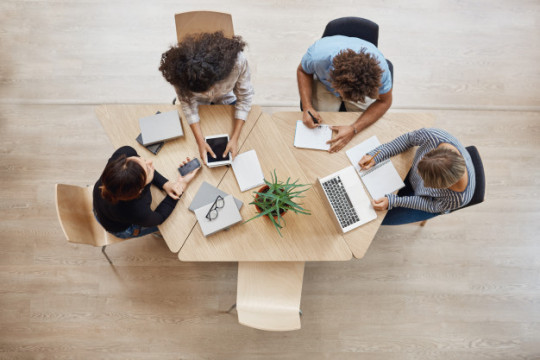
Desk, internet, coffee & co. but above all community management!
Coworking can also work in hotels and they are almost made for it. Through some conversations, some users have revealed that they would rather book a hotel that has coworking space.
But it must be a well-rounded and coherent concept. The offer cannot simply be implemented alongside it. You have to see it as your own profit center in the hotel and treat it the same way!
Community management is an essential part of the coworking space. Because it lives from the community, which consists of regular guests and members who come back regularly. They want to be recognized!
And a community wants to be managed!
The Community Manager in the hotel is the host and ensures a pleasant and smooth cooperation. He is the link between the community and the provider.
An example
Look at the Hotel Schani from Vienna! On the homepage you get an impression how this can be realized with the Coworking Space.
Conclusion
You can offer a coworking space in your hotel and thus improve and expand your guest relations! But it does not work on the side. It must be taken seriously! You need..
· Premises for the community
· separate offices
· Desks, printers, i.e. the equipment
· Community Manager or Guest Relation Manager for administration
· Administration and price concept
Coworking spaces in hotels and the new target group! (Part 2)

In the last article I have described the possibilities for hotels.
This article will now deal with the coworking space users.
Interview with a former Co-Working user
One of the founders of www.xperiens.de was kind enough to answer the questions from the user's point of view. He himself used coworking spaces because he was on the road a lot or needed a change from the home office.
With this interview I would like to try to find out the expectations and needs of the target group.
Question 1: Why do you use coworking spaces?
I like to use coworking spaces for several reasons. I travel a lot and need a relatively quiet place to work that has good WLAN and where I can drink a coffee or eat something. I don't always want to go to Starbucks & Co, but rather support coworking spaces - if they are available. Many times, they are not always close to the station, so that then I mostly visit one of the coffee chains. Since I also work a lot from home, I like to change the location to get new impulses and to get in contact with other people. Coworking spaces are predestined for this.
Question 2: How do you use coworking spaces?
I use coworking spaces differently. For concentrated work, I look for either a quiet place or even a room where I can close the door. If I work but don't necessarily need absolute silence, for example because I'm working through my emails or planning certain things in advance, then I like to use a workstation in a group room.
So a coworking space needs two things:
· Individual offices
· and group rooms
Question 3: At what time do you use it?
It really varies a lot. The other day, I had the most terrible accident. All day long my internet and phone were down. I urgently needed to get out of the way to work and went to a coworking space all day. But sometimes I only need a workplace for a few hours because I want to use the time until one or more appointments.
Flexible workplace design requires flexible pricing. Prices must be tailored to the user.
Question 4: What do you expect from coworking spaces?
It is important to me that everything is neat and clean. This includes the tables and chairs/armchairs as well as the meeting rooms, kitchen and toilet(s).
Then it is very important to me that there is fast and problem-free Internet and an easy to use access to the printer. I also find it helpful if there are lockers available, so that I can lock up something in the short term. As far as food is concerned, I like it when coffee, water and tea are provided free of charge and maybe a fridge to store my own things on hot days and a microwave to heat up something myself (even if I only order most of the time).
Question 5: How important is the community in coworking spaces to you?
Good cooperation is important to me. Friendliness and mutual helpfulness make up a community for me and in a coworking space everyone can benefit from the skills and abilities of the other participants.
I always find a wall helpful, where the individual coworkers and their activities are listed and/or described. This way, as a new visitor or coworker, you can find out who the others are and what they do for a living. Maybe this will lead to joint projects or if you have a problem, you will have a contact person you can ask quickly.

A coworking space is not just a room or a way to temporarily use an office. It is the community that makes up the coworking space. This community wants and needs to be cultivated!
As a result, hotels cannot simply provide a room, meet the requirements and provide good WLAN. They have to cultivate the community and make it possible to experience it. I think that will be the biggest challenge!
Question 6: Do you use marketing opportunities of coworking spaces?
...or would you take advantage of these services if they were included in the offer? For example: support at events etc.
I have used the marketing opportunities and have seen a lot of it so far. There is a blog on which the coworkers and their work are presented or there is a calendar of events, which is also sent out via newsletter. If someone offers a workshop, lecture or something like that it would be great to be listed there. For me it depends on what is offered concretely. Support at an event can mean everything, but coworking is about acting on your own responsibility. For example that the room is prepared and cleaned up by the organizer. I would find it helpful to have contacts to cheap catering or beverage suppliers if coworking has no offers in that direction. Especially if you come from far away, you don't want to transport the beverage crates.
Question 7: What prices do you consider acceptable?
This is a difficult question and depends on what is offered. I think round about 13-20 Euro is okay, if there are free drinks, fast internet, printer access and a good accessibility via public transport.
How could hotels implement the concept of coworking spaces?
I've been asking myself that question for quite some time. A temporary use of empty meeting rooms was my first idea. However, this complicates the administration and especially the marketing.
A coworking space must exist and be available. No user drives aimlessly to a hotel hoping that there will be a room available just today. And a hotel is reluctant to forego sales from a conference booked at short notice.
And yet even that could work every now and then!
0 notes
Text
Sustainability
by Nargis Mamedova, 01 April 2020, Hamburg
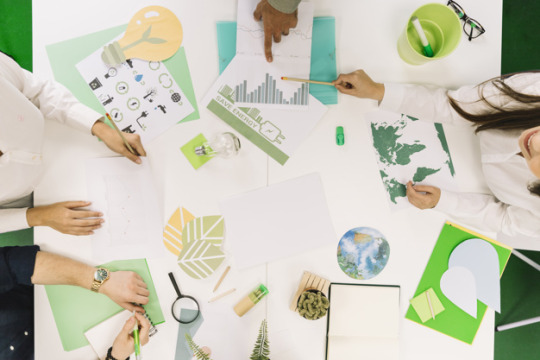
Environmental awareness and the sense of sustainability are not only relevant for the awareness of private consumers today. Awareness of sustainability has also become an important factor on the market in terms of business management. This has to do with the fact that sustainability today is no longer just a question of the economical use of resources. Rather, it is also connected with questions of holistic production and environmentally conscious consumption. Those who offer authentic concepts and make a name for themselves can win the trust of consumers and secure a good place in the market. What does sustainability mean in general?
Sustainability does not only refer to the professional world. We encounter it in almost every area of life and it has become very important in recent years. Sustainability is often mentioned together with environmental protection - which is not wrong in principle, as the two are closely linked. Nevertheless, sustainability and environmental protection must always be differentiated and examined separately.
ENVIRONMENTALLY FRIENDLY WORK IN COWORKING SPACE
The topic of sustainability is becoming increasingly important not only in everyday life, but also in the office. Sustainability can therefore be understood as a goal worth striving for.
Example https://www.nutrion.net/2020/02/27/coworking-spaces-und-nachhaltigkeit/
It always plays an active role in corporate cultures and is consciously carried to the outside world. A company that is perceived as a brand with sustainable corporate commitment and environmentally conscious production is gladly used by consumers.
The fact that coworking spaces are much more sustainable than individual offices is already well known to many. After all, it's not only the rent and electricity that are shared, but also the individual resources. This means that there is an increase in large orders which are significantly more environmentally friendly than individual orders. The printers are also shared by all coworkers, which saves further energy. In addition, more and more coworking spaces are aiming for plastic-free packaging and the use of environmentally friendly materials.
In the following I will explain which possibilities there are for making the working day in the office or coworking space more sustainable, and which of the following aspects it must fulfil in order to be called sustainable
Sustainability in the Office
The topic of environmental protection is not only becoming more and more important in everyday life, but also in the workplace where you can protect the environment with just a few tricks and even save money. Sustainability is therefore an important element for more and more companies, and is also used for their own presentation and advertising. In addition to the use of environmentally friendly office materials, it is important to pay attention to sustainability already when furnishing the office. Energy-efficient equipment is just as important as furniture produced in an environmentally friendly manner.
Healthy office equipment
Environmental protection begins with the furnishing of an office. Those who choose recycled or environmentally friendly furniture not only make an important contribution to sustainability, but also offer their employees a healthy and attractive working environment. Wooden furniture guarantees a pleasant ambience, but when buying it you should pay attention to the origin of the wood. FSC-certified office furniture offers a good guarantee that the wood comes from sustainable cultivation.
Other seals of approval that focus not only on sustainability but also on human health are the Blue Angel and the Golden M. These seals are only awarded to low-emission furniture and thus guarantee a healthy working environment without harmful emissions from adhesives and paints.
Environmentally friendly technology
Saving electricity is also one of the important criteria for an environmentally friendly office. This is achieved not only by switching off lights and electrical appliances when they are no longer needed, but also by using energy-efficient equipment. Energy-saving devices are not only good for the environment, but also reduce the ancillary costs in the office and are therefore particularly attractive.
purchase green electricity
In addition to energy-saving appliances, the purchase of green electricity also guarantees an important contribution to climate protection.
Save and recycle paper
The electronic exchange of information not only saves raw materials, but also time and money. For necessary printouts environmentally friendly paper with recycled content should be used.
Properly practiced sustainability communication ultimately helps to strengthen the perception of the company as a "good brand" or a "good company" by increasing its reputation, thus promoting corporate success. The design of this communication in terms of differentiating and positioning is a strategic and creative challenge that every company or brand can master individually.
0 notes
Text
Coworking Space
by Nargis Mamedova, 19 March 2020, Hamburg

Furthermore I would like to continue my blog with the topic Coworking Space. I will split this blog into two parts. With this blog I want to show what coworking means at all and how it relates to my project.
Coworking
Coworking is a new form of work that has emerged in Silicon Valley. Most start-ups, freelancers and creative professionals rent a flexible workplace in an open-plan office and want to take advantage of the benefits of working together. A coworking space focuses on the needs of entrepreneurs, creative and knowledge workers.
In addition to the workspace, the focus is on building up a network for knowledge exchange, innovation and further training, which will help coworkers to advance in their entrepreneurial activities". (from Schürmann, M. (2013): Coworking Space. Business model for entrepreneurs and knowledge workers).
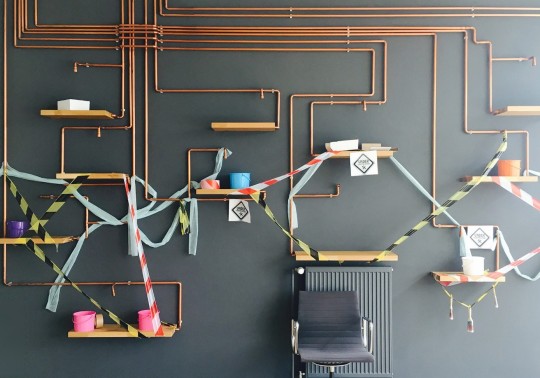
CoWorking: What is that?
It is wrong to say that coWorking is only a term for office sharing. This working model involves so much more than sharing an office and the costs it entails. CoWorking does not mean working parallel to each other, but getting in touch with each other, exchanging ideas, supporting each other and providing each other with creative ideas and impulses. It is a fruitful symbiosis of different people from very different industries. The more diverse the audience, the better.
When working together in CoWorking, five fixed values are important. Cooperation, community, sustainability, openness, accessibility
In the next blog I will bring the individual values closer.
In addition to these core values, each CoWorking Office has its own profile. While some focus on family friendliness, others specialize in sustainability in all its facets. It is also very popular and absolutely trendy to combine CoWorking with the Maker Space concept.
The flexible use of the CoWorking Spaces
We now know: CoWorking Spaces bring people together and promote exchange. Furthermore, they can be used in a completely flexible way and therefore adapt ideally to every CoWorker. Those who rent an office space can use it either by the hour, by the day or by the month. Some spaces even offer year-round use.
Furthermore, there are various tariffs, ranging from the basic model in an open-plan office and various extras to the luxury version with an individual office and access to all technical equipment. In other words: CoWorking Spaces offer the right solution for every concern and every budget.
Who is CoWorking interesting for?
CoWorking Spaces are places where the most diverse people with the most diverse professions and qualifications come together. What unites them is the desire to exchange ideas, to network and also to support each other.
Freelancer: Freelancers working on different projects are in good hands in the CoWorking Space. The offices represent a low cost factor and are at the same time a welcome change to the otherwise rather lonely everyday work.
Startups: But not only sole traders and freelancers feel at home in CoWorking. Young start-ups, which are currently in the start-up phase and often do not have enough money for their own office, also gratefully accept the corresponding offers. Furthermore, the contacts that can be made here are of value.
Employees: In most cases, employees who already work in a home office use the possibilities of the Spaces to escape the loneliness and monotony of their home office.
Creatives and artists: CoWorking Space is by no means limited to working with a laptop and graphics tablet. Numerous offices offer enough free space, which is also used by artists and creative people to put new projects into practice.
Personal trainers: The same applies to personal trainers who can hold their sports courses in appropriately equipped rooms.
Digital nomads: Yeah okay, most Digital Nomads can be counted as freelancers. They should nevertheless be mentioned separately in this list, as they make it clear that CoWorking Offices can be used not only in the home town but all over the world. Those who work independently of location now have the opportunity to rent a CoWorking Space worldwide and to establish international contacts there.
Advantages
Use of available resources: Most coworking spaces are equipped with high-quality technology.
Expanding the network: A professional, well-developed and high-quality network is essential for a successful career.
Venue: Coworking Spaces are often also used for seminars, workshops, lectures, networking events, etc. If you don't have suitable premises, you could certainly collaborate with coworking providers and benefit from this collaboration.
Increase in performance: When the ceiling falls on your head and you are stuck in a creative dead-end, it is high time for a change of scenery. CoWorking Spaces as a new, inspiring environment can certainly contribute to an increase in performance and thus help you out.
Continuing education: When you meet different (foreign) people in the CoWorking Space, you can benefit from an extremely high-quality exchange.
The Frauenhofer Institute 2014 study concluded, among other things, that CoWorking exerts an incredible fascination on different people. This fascination is also the reason why the working model has long since become more than just a trend. Freelancers as well as companies are always finding new ways to actively use CoWorking and to benefit from the resulting advantages.
0 notes
Text
Interior design - living brand identity in offices
by Nargis Mamedova, 24 June 2020, Hamburg
This moment when the users move into a room/office is an important phase in a successful interior design project.
Work changes change faster than superficial interior design can react
In recent years, the working environment has changed dramatically. Not only have technologies and work changed, but also the structure of offices, from private rooms to open structures.
Open-plan offices are attractive for employers because they allow employees to work more closely together. This aspect is relevant, but the well-being of employees and their work performance should not be ignored: Frequent disturbances and high noise levels are among the most important stress factors in working environments. Influences such as conversations with colleagues, phone calls, conversations with colleagues and social media distract employees. Working in an open-space office means multitasking, the distractions must be eliminated.
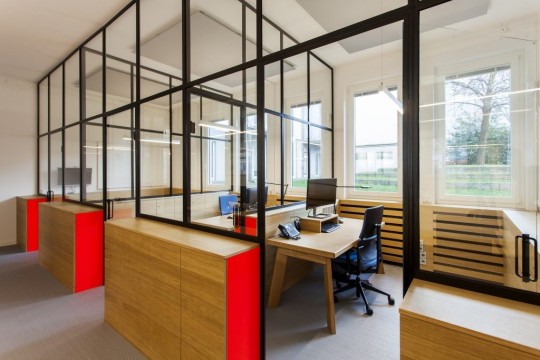
For interior designers in office environments this means that the conditions of the premises have to be in harmony with the well-being of the employees. For designers of office environments this means that they have to balance the given financial and spatial conditions with the well-being of the employees. One of the biggest advantages of open space offices is the collaboration between employees. This way of working can be more efficient than people working in individual offices.
To increase productivity, collaboration must have a suitable spatial environment. Office space must be well designed to realize its potential and function well, so that after a few years there is no need for radical changes.
Create recognizable spaces by avoiding generic design decisions
Interior design can change the behaviour of employees. Nowadays, many of the current office designs look very similar and therefore it is often difficult to tell from the interior design what companies actually do. Interior design can also be a corporate design if it is general. Through the working environment it is possible to make the company look unique. Only by choosing furniture, colours or changing the walls, the interior design does not create a brand identity and therefore does not improve the working conditions. Most of the time the outside of a building remains unused. The visibility of a company can be increased by an attractive temporary outdoor workplace.
Activities
In the beginning it is important for every interior design project and also the biggest task to get to know the people as well as the company and their work. Getting to know the company and the work, means understanding how the spaces are used. In this way, it is possible to adapt the activities to the spatial environment, which then ideally suits the work. An ideal office should offer spaces that are appropriate for work - different areas for different activities help to increase the well-being and productivity of employees.
I think that working together in one room is of great importance. After all, when designing a room, it is crucial to change the behaviour of the users as well. Each person has different abilities to control his or her stress and working methods, so there is no "right" solution that can be adapted to every room. Nevertheless, there are some points that always have to be considered first - such as lighting conditions, noise reduction, and reduction of certain distractions.

Bringing the Corporate Identity to life
The offices have to meet a number of expectations as they become a brand. Therefore, interior design is important for retaining applicants. After all, the workplace helps to convey the brand value to visitors and at the same time makes it easier for employees to identify with the services and products, as they experience it every day in their working environment.
A good interior design corporate is more than just the CI colors on the carpet or the placement of the company logo. Interior design has become a brand of corporate culture - therefore employers cannot afford to ignore the interior design corporate. A well executed Corporate Interior Design is more than just using the CI colours on the carpet or placing the company logo on the wall behind the reception desk. The interior design of a company reveals the corporate culture. Fewer and fewer employers can afford to ignore the importance of corporate interior design.
A floor plan says a lot about the hierarchies in an office, just like the dress code or job title. In the best case, the Interior Corporate not only identifies the company visually, but also functions like the company. For example, an advertising agency or an IT company has a different design corporate than a law firm because the work activities are different for everyone. Corporate values can be communicated visually if the company has placed its emphasis on transparency. The same applies to creativity, reliability or really any company value. Therefore the biggest task of interior designers is to understand the company - how they want to see and develop themselves. A perfect interior design corporate represents the company and the employees who make up the company from its best side. It is a brand, every detail is a part of the brand.
0 notes
Text
Critical Thinking
by Nargis Mamedova, 08 March + 24 June 2020, Hamburg
Critical thinking is often seen as an important "key qualification" for making better decisions regarding processes and products. Although critical thinking is often required, it is rarely defined what critical thinking actually is or is necessary for it.
I would like to start my first blog with the topic 'critical thinking'.
What is critical thinking?
Here is a first attempt at an own definition:
"The ability to question information of any kind, including the ability to study manipulation and falsification, intentional or unintentional."
Targeted as Wessel, D. (2011). What actually is critical thinking? wissens.blitz (45). https://wissensdialoge.de/was_ist_kritisches_denken
Critical thinking as a skill
In literature, critical thinking is often seen as a skill. This includes, for example, the "conscious, self-regulating formation of judgement, which includes interpretation, analysis, evaluation and conclusion".
The most important thing here is independent research - information search, analysis, conclusions, without distortion - i.e. without, for example, giving preference to information that corresponds to one's own opinion (confirmation bias, I try to confirm what I already think is right instead of actively looking for possible refutations) or neglecting or devaluing counter positions (myside bias, I am not objective but argue for my position).
5 criteria for critical thinking
"While there is no universal standard for what capabilities are contained in critical thinking ..."
Identification - The first step in the critical thinking process is to identify the situation or problem and the factors that can influence it.
Research - When comparing arguments on a topic, the ability to conduct independent research is crucial.
Conclusion - The ability to draw conclusions based on information presented is another important skill for mastering critical thinking.
Determining relevance - One of the most difficult tasks in critical thinking is to find out what information is most important to your consideration.
Curiosity - Being able to ask open questions is an important skill to develop - and bonus points to check
Why critical thinking?
The skills and personality traits for critical thinking do not develop by themselves over time. Even university students are often unable to think critically, or only insufficiently so. The quality of our life and all things we create, produce or construct depends directly on the quality of our thoughts. Critical thinking can be learnt and can be applied across all areas
Critical thinking means in short: self-controlled, self-disciplined, self-monitored and self-correcting thinking. It requires the affirmation and mastery of strict quality criteria. It leads to effective communication and problem-solving skills.

Critical thinking in interior design
Abstract
Critical thinking in interior design are theoretical and historical ideas that influence changes in architecture and interior design in order to clarify the points of interpreting and describing, which are part of interior design criticism.
What is criticism?
Critique is a train of thought of criteria in the process of evaluating and judging the value of what has been achieved. Because interior design is more than just the embellishment of rooms or the art of surfaces and forms of architecture, interior design practice and interior design criticism require theoretical ideas that explain and structure everything. When we discuss a work, our judgment is affected by cultural and social attitudes, as well as by. The development of a theory provides evaluation criteria for assessing existing design work as well as for evaluating one's own design ideas. Criticism is often spoken about in a way that presupposes understanding of the content, but is nevertheless confusing because certain criteria are missing.
Structure
Designers often define their concepts as "intuitive designs" without a clear statement of why this decision was made. In fact, there are clear intellectual ideas that put designers in a position to judge the value of designs. If one were to build a model based on this intellectual inspiration, the structure would consist of three elements: form, concept, technology.
The form eats a three-sided idea. On the one hand it serves as proportion, as space and as structure. Proportion is often discussed. It is an abstract property of a space and serves for an ordering effect. The form is probably the most useful idea, because it includes the architectural whole with the interior design. The development of the form leads to reflection - ideas are worked out and designs are expressed graphically.
The next element is the technology that serves as the design task for the solution. It is what the designers bring to the design work. The prerequisite for designing interiors is an understanding of construction, material line and lighting. Through the means provided by technology, a conversation is stimulated.
0 notes
Text
Research in design
by Nargis Mamedova, 25 June 2020, Hamburg
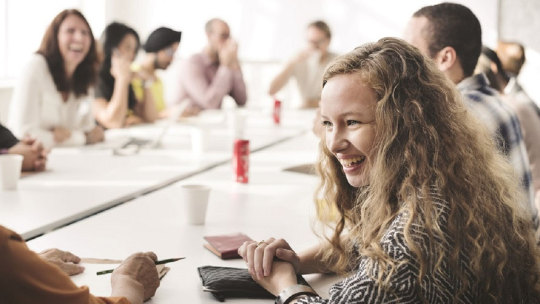
I would like to start my blog entry with the topic, Research in Design. I hope that I can build my blog in a way that it is understandable for all readers. I will try to merge topics of design and the innovation concept of my master project.
The Design Department is extremely active in the field of research and development. In addition to application-oriented industrial projects, extensive research projects with scientific questions are carried out at the department. The research topics that are dealt with in projects of the Interaction Design Lab also play an important role. The strong reference to research topics and the numerous cooperations with institutions and commercial enterprises ensure a very high level of education at the faculty of design.
The following research topics are currently being intensively pursued and worked on in the Department of Design:
Data visualization
Sustainable Design (Sustainable Design)
Design Tool Design (design tools)
Image, dramaturgy, visuality
Identity, information, staging
Design research (focus on product design)
Data visualization
In the area of data visualization, different presentation strategies for extensive and complex data sets are developed and investigated. An important research aspect is the topic of "Information Aesthetics" - i.e. the question of how the perceived aesthetic quality of visualizations affects the understanding, interaction, and action competence of users.
Sustainable Design (Sustainable Design)
Sustainable Design examines the question of what role interface and interaction design can play in the development of sustainable products and services. This is not only about the design of more energy-efficient products but also about education and the question of whether a change in user behaviour can be achieved by design means.
Design Tool Design (design tools)
Design Tool Design is concerned with the question of what new tools designers need in order to be able to cope with the increasingly complex problems in design. The creative use of high tech requires new tools: only new hardware and software, which give the designer all the freedom he or she needs and are also easy to learn, will make innovations possible.
Image, dramaturgy, visuality
The research field "Image, Dramaturgy, Visuality" is concerned with the discovery, naming, exploration and discussion of visual phenomena and dimensions of effect that arise from the context of images, illustrations, signs, texts and contexts in their intention, use, perception and effects. The thematic field "Image, Dramaturgy, Visuality" is interested in all fundamental questions of perception of static as well as moving or changeable as well as differently complex signs, images, contents.
Identity, information, staging
The thematic complex "Identity, Information, Staging" examines the possibilities of the creative interpretation of information against the background of communicative intentions and interaction. The possibilities of syntactic transformation are as much in focus as the anticipation and perception of staged information and the question to what extent design can influence the relationship between man, machine, object and bodies. Design is examined as an informative and identity-forming surface for structures and functions.
Design research (focus on product design)
Questions in design usually refer to the general conditions or the closer context of concrete product development. In contrast, the master's focus on design research asks for more general conditions of product design. In addition to a basic knowledge interest, which is aimed at developing a time-adequate, well-founded education, the main focus is on an understanding of possible effects of specific actions, taking into account causal conditions, and thus on a (new) understanding of responsible action, i.e. the question of the relationship between design and ethics.

Design and aesthetics
Design is language and design changes language. Design is time-based - consequently there is no binding formal code. It is about an understanding of the dynamics, the conditions of syntactic, semantic development and about the critical reflection of formal criteria or formal quality in relation / dependence on contemporary questions and concepts. In addition, the focus "Design and Aesthetics" attempts to occupy a thematic field that has generally not played a role in design education to date.
0 notes